How to Prepare for Your First 25 Mile Bike Ride
Updated 6/2/24
A 25 mile bike ride is an exciting challenge for all beginner cyclists that want to push the limits and explore everything that a long-distance ride has to offer.
When I first thought about doing a 25-mile ride, I knew that I would need to prepare mentally and physically to be successful and feel well enough to want to do it again in the next week or maybe even the next day.
Preparation for my first ride was key one.
You will probably be unsuccessful or maybe regret doing a long ride if you haven’t built up your endurance, figured out what to wear, and don’t have or know how to use the equipment you need for your ride.
And what about the route that you should take? Are there hills or no hills? Are you going over bridges, and do they allow bikes?
As you can see, a successful ride is all about the planning.
Aside from the physical aspects, I also focus on the mental game.
Keeping a positive attitude and having strategies to get past tough moments are super important.
I remind myself why I’m doing the ride and what I hope to get out of it. Whether it’s just for personal satisfaction or to enjoy nature’s beauty, there are plenty of reasons to take on a 25-mile trek.
With the right preparation and attitude, the distance is not just a number but a journey of self-discovery and adventure.
This post contains affiliate links. As an Amazon Associate, I earn from qualifying purchases. This means I may earn a commission, at no extra cost to you, should you choose to make a purchase using my link.
Bike Maintenance Tips:
- Always keep your bike clean – This is important for any bike rider that doesn’t want to get stranded somewhere or end up buying and replacing expensive bike parts. Your bike will ride much smoother if you keep it clean.
- Check Tire Pressure – Low tire pressure can make you work harder on your bike ride. Not to mention it can cause damage to your tires. So just double-check that you have the right tire pressure for a smooth easy ride.
- Learn how to fix a flat tire – It may come in handy to know how to patch your tire when you are several miles from home. I hope that I never have to do this, or I am close to home if it happens. But if not I’m glad I took the time to learn.
- Make Sure Lights Are Working – I use my lights all of the time. Not just when it is dark out. I think that the cars notice the lights more than my bike.
- Check your Mirrors – Ok, seriously, I learned this one the hard way. I had just cleaned my bike before I took off for my first 25 mile bike ride. Somehow the screw on my left mirror loosened. A few miles out, it started bouncing around, and I had to hold it while I rode to keep it in place. Not fun and not safe. Also, be sure to clean your mirrors so that you can get the best view behind you.
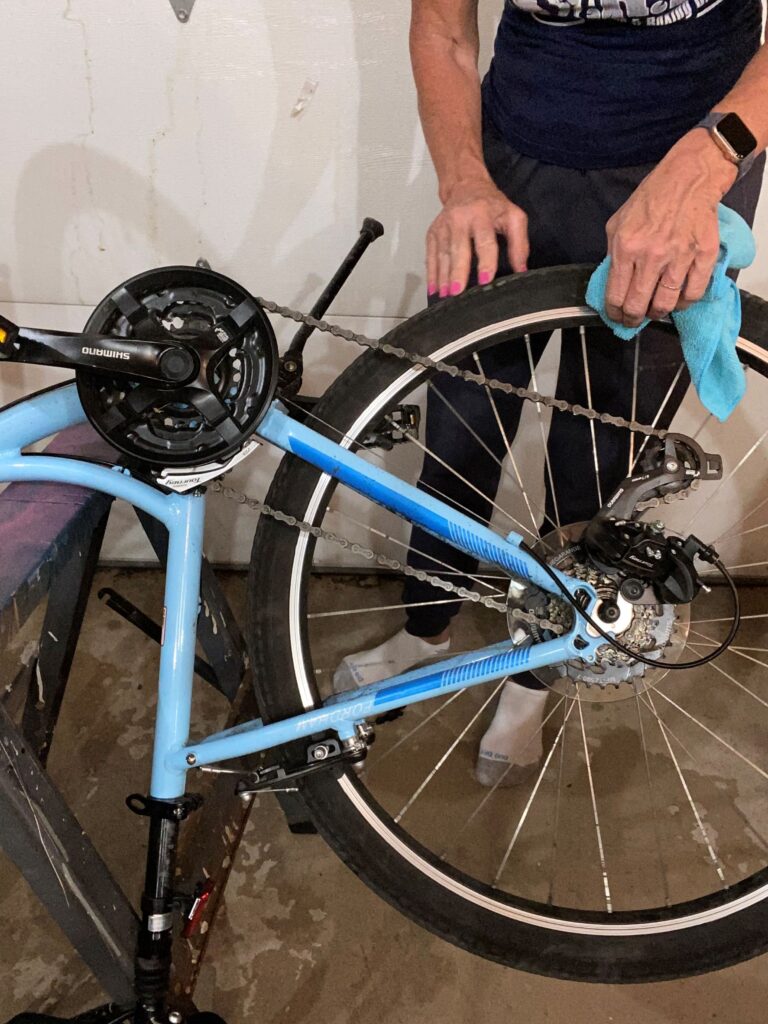
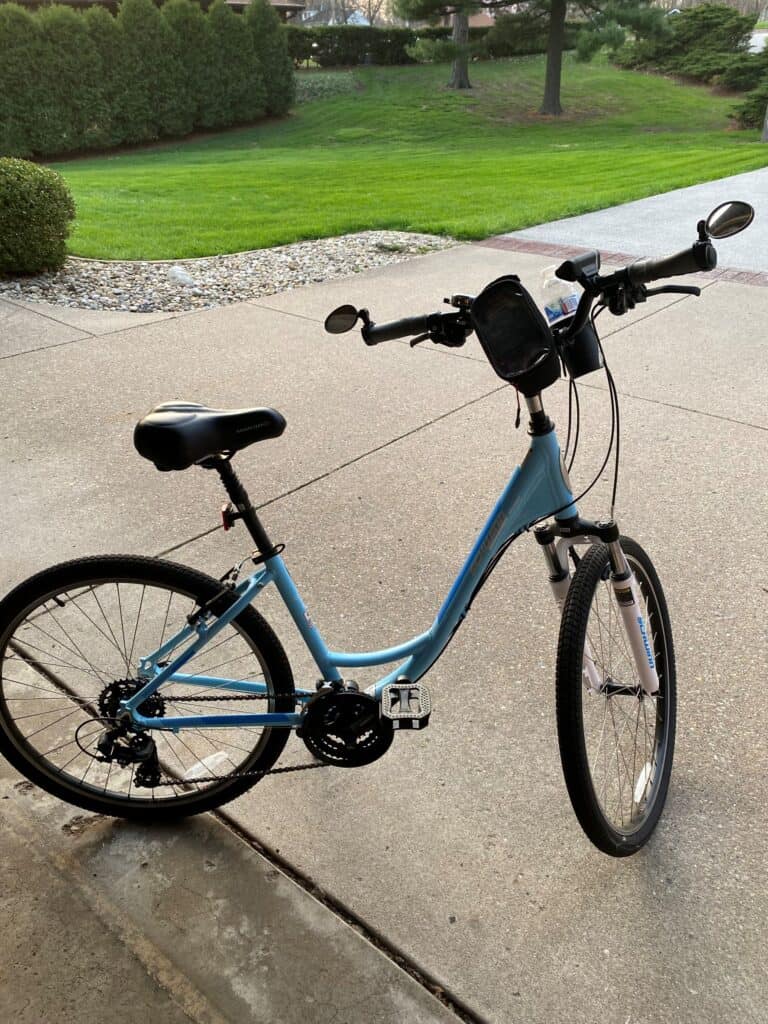
What To Wear On a Long Bike Ride
Helmet
For me, this is non-negotiable.
It’s a low-dollar item that can save you from a head trauma if you fall. A concussion can take you out of the game for a long time.
Helmets should fit snuggly so it doesn’t bounce around. They can also help in keeping the sun out of your eyes and the bugs out of your hair.
READ MORE: Should New Bicyclists Over 60 Wear A Helmet? | Simply Aging Healthy
Bike Shorts
I highly recommend bike shorts, especially for long rides.
When I first saw a pair of bike shorts, I was like, “absolutely not, I will never wear those”. I didn’t get the extra butt and crotch padding.
Well, never say never!
After my first long ride, I had horrible low back pain, and oh my god, the chaffing was unreal. I had to rethink my strategy.
After talking to people that reported low back as well as butt pain and their bike shorts experience, I decided to give them a try – game changer! I will never go for a long ride without them again.
Eye protection
The sun, the bugs, and the elements can really cause big problems with your eyes.
There is nothing worse than getting a bug in your eye while riding in traffic.
Of course, sunglasses are best to protect your eyes from the sun, but if you’re not a fan, you could try a protective shield on your helmet. This works just as well.
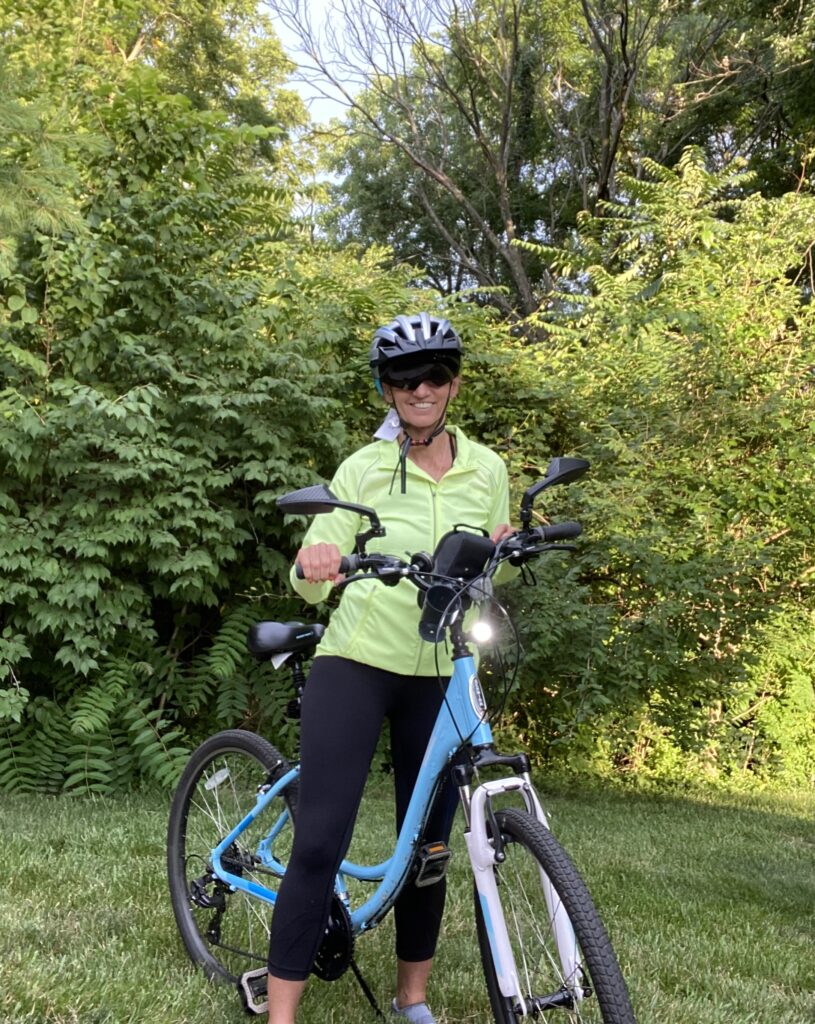
Sunscreen
This is very important.
Regardless if it’s sunny or overcast, you will get the effects of the sun.
A sunburn can lead to dehydration. This can leave you feeling sick and weak for days after your ride. You should also reapply as needed throughout your ride.
Gloves
Another little item that I did not feel was necessary but later found out that they are very important is gloves.
My hands would get sweaty and cause my hands to slide off my grips – not good.
You may also want to find a padded pair to help with hand pain. If you don’t want to wear them all of the time, at least put them in your bag because you may want them after a few miles on a long day.
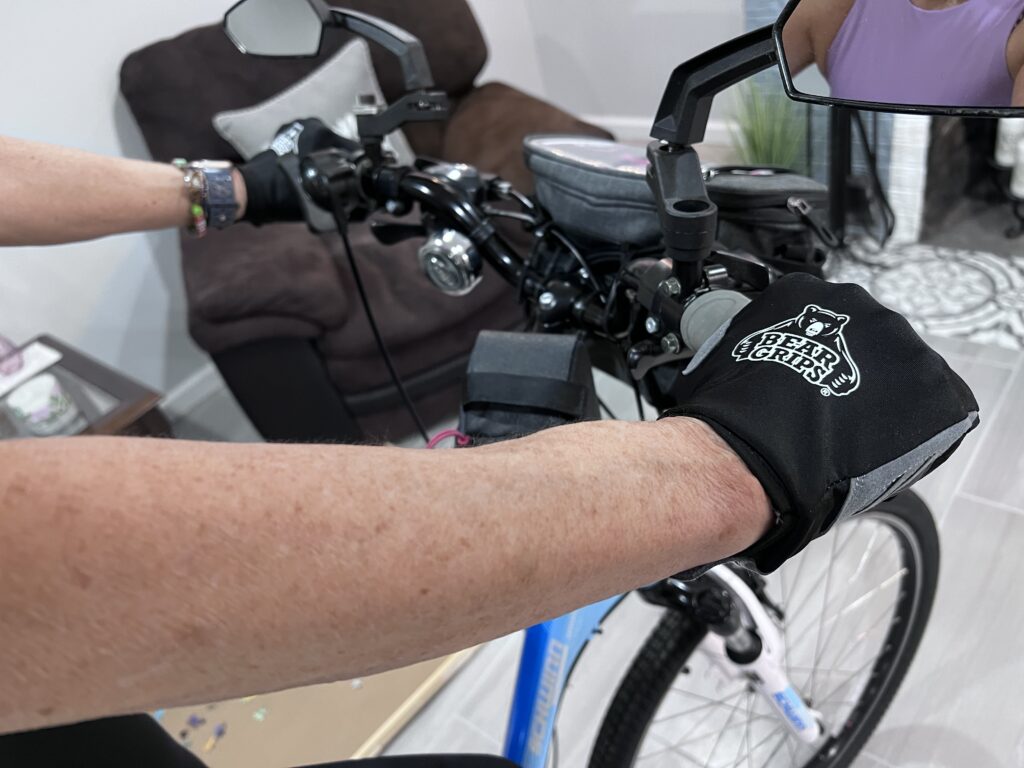
Breathable Clothing
Make sure that the clothes you wear are sweat-wicking and breathable.
Also, make sure that they are weather-appropriate – layering is the best way to keep your body temperature in check.
What To Take On Long Bike Ride
Cell Phone
I feel that it is your best lifeline if you fall or get stranded somewhere.
It’s also great to guide you on your route or help you if you need a new route for some reason.
Back Pack
I have a pouch on my bike that I use most of the time for my loose items.
However, I’ve also found that a lightweight backpack that can be rolled up so that it fits into my pouch can be handy.
If you need to stop at the store to pick up some water or other items before you head back home a larger option, like a backpack is great to have.
Cash or Credit Card
You should always have some extra cash, a credit card, or something like Apple Pay on your watch when you ride.
It could save you if you need to stop for sports drinks or snacks. You don’t want to bonk on your ride because you don’t have enough fuel to get through.
It could even come in handy if your bike breaks down and you can’t ride back home. You may need to stop at a local bike shop or get a ride.
Snacks
On a longer ride, you should try to stop at least every 30 minutes for a snack and water break.
Your body can only supply so much glycogen for energy, so you don’t want your energy to crash. Gel packs, trail mix, or even almonds and bananas will be helpful.
Water Bottle
Every ride, no matter how short or long, should include a water bottle.
A simple water bottle holder on your bike will keep this out of your way but handy when you need it.
You don’t want to dehydrate while you are out riding. By the time you feel thirsty, you could already be dehydrated. Make it a point to stop and take a drink.

First Aid Kit
I usually just take a few band-aids and gauze with me.
But if you have the room you may want to include a first aid kit with antibiotic ointment, rehydration salts, ibuprofen, tweezers, bee-sting kit, and athletic tape. Or whatever you feel that you may need along the way.
Bike Lock
You just never know when you might need to make a quick stop. If you have to run inside a store or a coffee shop, it won’t take long for your bike to disappear.
The best locks are u-locks, but even a chain lock that works for a short period of time will work.
Emergency Contacts and ID
It’s a really good idea to take along a few emergency contacts and your ID.
Cell phones usually need face recognition or a password to get into, so emergency personnel will never know how to find your emergency contact.
So, be sure to put a piece of paper with your name, emergency contact person’s name, and phone number either in your bag or in your helmet.
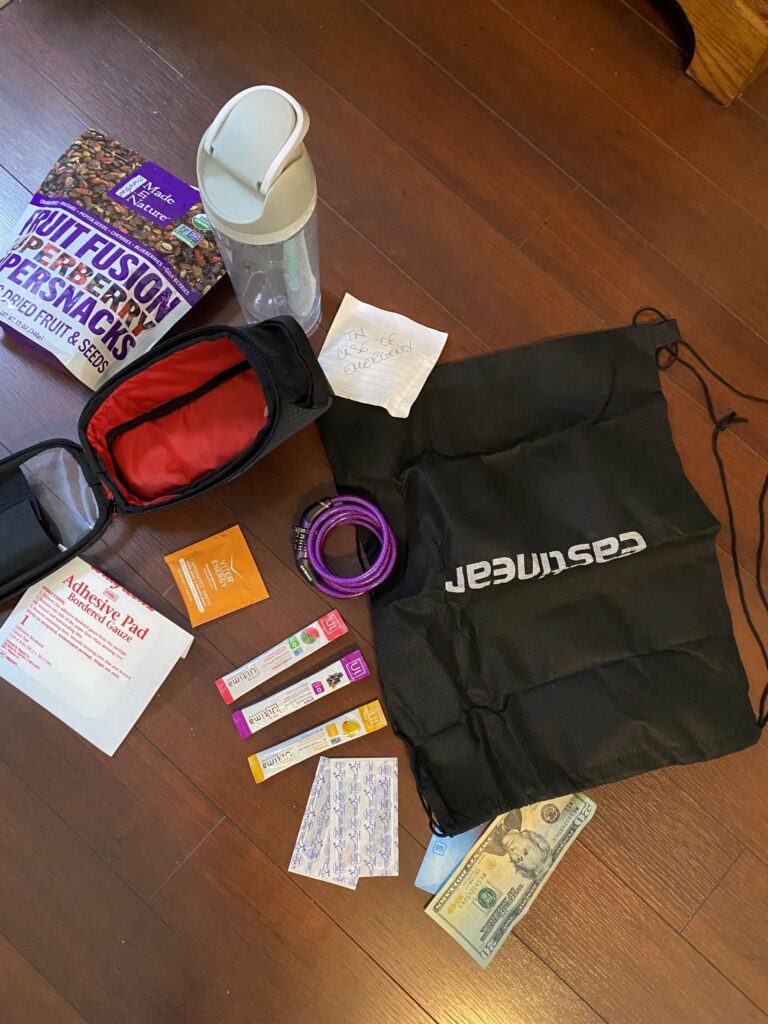
Building a Training Plan
OK, now that you know what you need to prepare for a 25 mile bike ride, you need to figure out how to prepare your body for the ride.
This is extremely important.
Setting Achievable Goals
My first step is to always set my goals, this helps to keep me motivated.
Goals should be SMART. That means that they are: Specific, Measurable, Attainable, Relevant, and Time-bound.
A great cycling goal when training for a long ride would be to increase your ride distance by 10% each week.
READ MORE: Setting Cycling Goals For Beginners? Look No Further | Simply Aging Healthy
Incremental Training Schedule
You should do an incremental training schedule, this helps your body adjust to longer distances over time.
A good training tip is to plan three main types of rides each week:
- Long Ride: Gradually increase the mileage so that you don’t overdo it too quickly.
- Short Recovery Ride: Keep these light and at an easy pace to help muscles recover.
- Speed or Hill Training: Alternated weekly to improve your cycling power and aerobic capacity.
First Week Plan Example, should include a long endurance ride of 10-15 miles, a short recovery ride of 5 miles, a hill training day and a strength training day.
Also, make sure that you add rest days in your cycling training plan. These are just as important as training days.
READ MORE: Recovery Ride Vs Rest Day? For New Senior Riders | Simply Aging Healthy
Be sure to track your progress and adjust the plan as needed, you want consistent improvement without causing an injury. You want to progress at your own pace.
Preparing for a Long Ride
25 mile bike rides are great for all beginner cyclists that want to try a long ride. But in order for this to be successful, you must start with a little planning for a ride of this distance.
The best thing that you can do is prepare your bike, wear the proper gear and pack the important supplies to make your ride successful.
By setting goals and following the training tips above, you will continue to improve and stay safe on the road.
Before you know it, you will be riding with the experienced riders and planning for your first 50-mile ride or even century ride!
So, I would love to hear about your furthest ride and what preparations you recommend.
